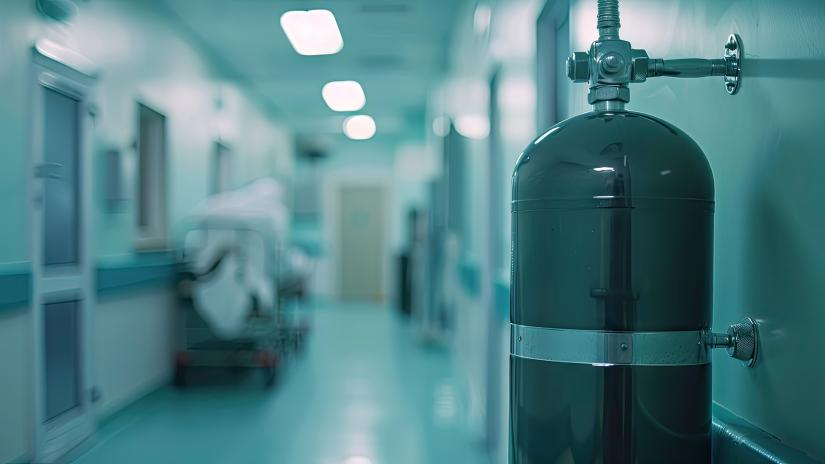In the hospital ED, small changes are driving green outcomes
A new research project is focusing on reducing the use and impacts of oxygen cylinders and associated equipment within the emergency department (ED).

Hospitals exist to enhance human health, but some of their activities might inadvertently making it worse: the health sector is one of Australia’s biggest carbon emitters, contributing to global warming and the countless health impacts (heat stress, infectious diseases, natural disasters) that result.
“If the health system was a country, it would be the fifth largest country on the planet in terms of carbon emissions,” says Professor Margaret Fry, Professor of Emergency and Critical Care for the Northern Sydney Local Health District (NSLHD) and the UTS Faculty of Health. Professor Fry’s research sits within the Faculty’s Climate Change and Health Collaborative, which is part of the transdisciplinary Institute for Innovative Solutions for Wellbeing and Health (UTS INSIGHT).
Direct emissions from health care facilities and vehicles, combined with indirect emissions like energy usage and the manufacture and transport of consumable goods and pharmaceuticals, mean that in Australia alone, health care contributes 7 per cent of the nation’s carbon footprint. It’s no surprise, then, that sustainability is a hot topic of conversation in hospitals around the country.
If the health system was a country, it would be the fifth largest country on the planet in terms of carbon emissions
– Professor Margaret Fry
Taking the lead on hospital-based sustainability initiatives
In New South Wales, Professor Fry is co-leading a research project at Royal North Shore Hospital focused on reducing the use and impacts of oxygen cylinders and associated equipment within the emergency department (ED). Currently, these cylinders are placed under every bed within the ED for use by patients who require supplemental oxygen and need to be transported to other areas of the hospital.
Having them readily available under the beds makes them easily accessible to clinical staff, saving the time required to retrieve them from elsewhere in the facility. But these cylinders also bring with them a range of sustainability challenges. As well as the embodied carbon involved in their production and transport to and from the hospital, they need to be regularly refilled — not only when they’re empty, but when they’re partially full or have been unused for a period of time.
“You’ve got to have a certain amount of gas in the cylinder to be able to use it with equipment like ventilators, so we would always replace them if they were a quarter full. That means there’s all that gas you’re disposing of, which creates significant waste,” Professor Fry says.
The research is focused on identifying ways to reduce the carbon footprint and unnecessary waste associated with these cylinders. Researchers will measure the impacts (cost, carbon emissions, operational efficiencies) of minimising the number of cylinders that are kept in the ED. It will also consider the potential ramifications on patient health of not having the cylinders immediately available — a low-risk proposition in a department where wall-mounted oxygen taps are positioned above every bed.
This project is a stellar example of how even incremental changes can lead to significant sustainability and other savings over time: currently, the ED orders more than 2000 cylinders per year at a cost of over $55,000 and 501 kg of carbon emissions. Removing the cylinders is expected to save around $15,000 and cut the associated carbon emissions almost in half.
The research is also likely to lead to an increase in operational efficiencies by cutting down on the staff time required to order, position, test and maintain the cylinders — processes that require hours of dedicated nursing time every week.

Working together towards a greener health sector
While the project is largely a nursing initiative, it’s being delivered in consultation with a multitude of other disciplines. The advisory board overseeing the work, of which Professor Fry is a member, is comprised of nurses, doctors, allied health professionals and clerical staff, while the project itself is a collaboration with the ED’s medical team.
“You don’t really initiate anything in the hospital setting without generally having discussions within the multidisciplinary team,” Professor Fry says.
“There might be flow-on impacts that you haven’t considered in the initiation of a new research study. It adds a layer of complexity to the work, because emergency care is delivered by a team and all roles need to be considered when undertaking new initiatives.”
Professor Fry and her advisory board colleagues are currently overseeing a wealth of other sustainability projects within the ED, including an initiative to recycle asthma inhalers for respiratory patients and another to re-use clinical consumables. While she acknowledges the single-unit impacts of these sorts of projects are modest, the potential flow-on effects of this sort of research are massive.
“The ED is a high-volume clinical area, which means significant strategies can be implemented with profound impact for planetary health,” Professor Fry says.
“Our research successes have the potential to be rolled out not only in emergency departments across our local health district but potentially across New South Wales.”
